48.4 HUMAN INFLUENCE ON EVOLUTION
It has sometimes been claimed that as humans exert increasing influence on nature, evolution will grind to a halt. Nothing could be further from the truth. As examples in the preceding sections show, what is changing, and what will continue to change as the human footprint grows, is the selective landscape within which evolution operates. Some species, for example rats and cockroaches, thrive in the urban environments we have constructed for our own benefit. Others will expand or decline as we replace prairies and forests with crop and pasture land. What are our conscious and inadvertent effects on evolution and biodiversity?
Case 8 Biodiversity Hotspots: Rain Forests and Coral Reefs
48.4.1 How has human activity affected biological diversity?
As noted in Chapter 1, it has been estimated that humans make use of nearly 25% of the entire photosynthetic output on land. That is, through the crops and livestock we harvest, the biomass we burn, and primary production we eliminate when we clear-cut forests, we use one in every four grams of organic matter produced by land plants. Ecologists also estimate that crops cover 10% to 15% of Earth’s land surface, and pasture land another 6% to 8% (Fig. 48.18).
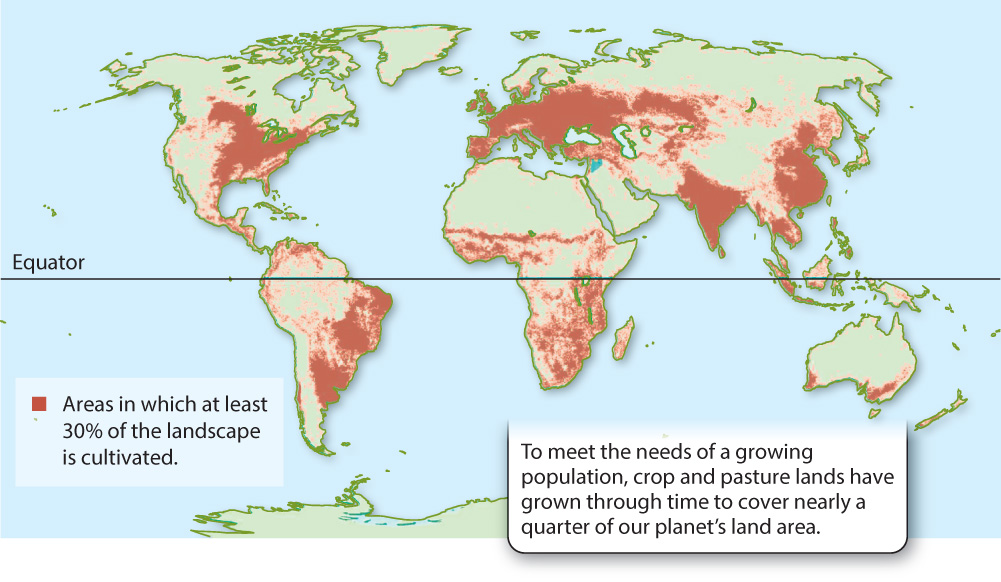
The populations of a few species have expanded dramatically during the Anthropocene Period. For example, 10,000 years ago, corn (Zea mays) was an inconspicuous herb in southwestern Mexico; today, corn fields cover nearly 150 million hectares (ha) across the globe. As crop and pasture lands expand, along with urban and suburban environments, indigenous populations become displaced and their natural habitats disrupted.
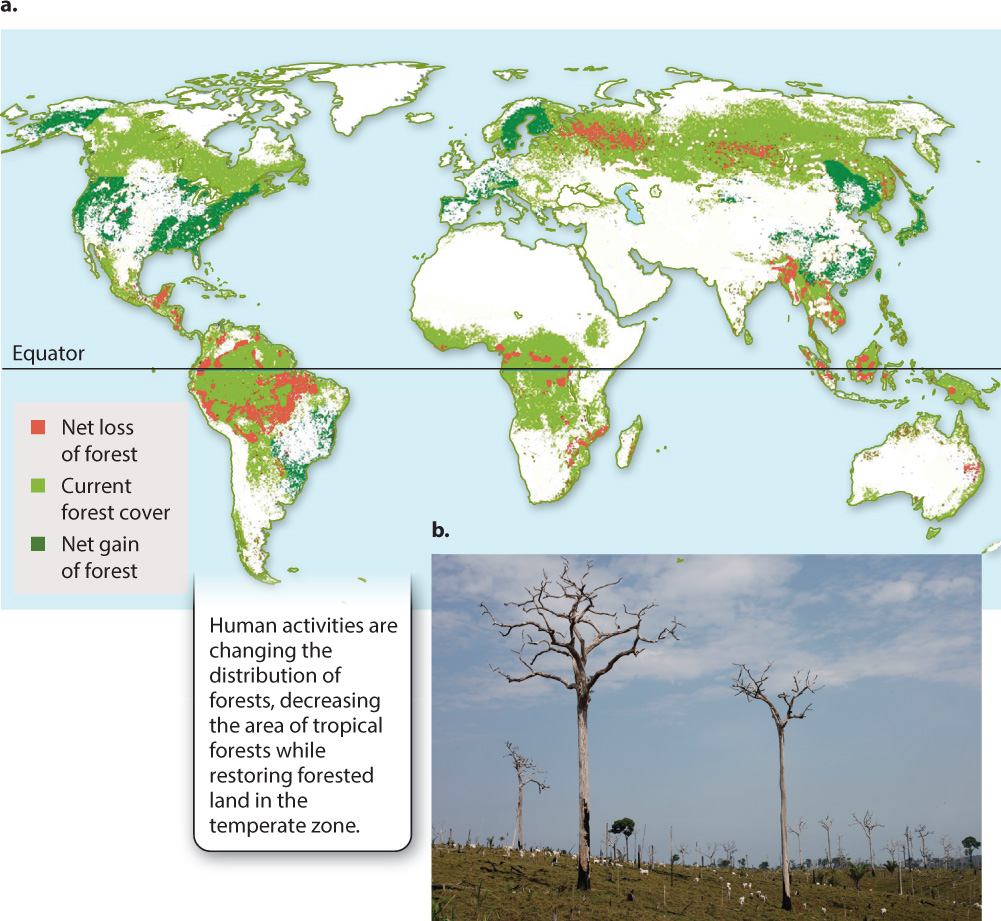
Habitat loss in tropical rain forests poses one of the most important threats to biological diversity (Fig. 48.19). These forests represent the greatest hotspots of biodiversity on land, but clear-cutting for grazing and croplands has destroyed more than half of their pre-industrial area. It has been estimated that deforestation over the next century could eliminate 40% to 50% of all tree species in the Amazon forest.
As the forest disappears, so, too, will untold numbers of insect, mite, and other animal species. The renowned biologist E. O. Wilson has estimated that Earth is losing 0.25% of its species annually—that is, 5000 to 25,000 species per year, depending on how many species actually exist. In the words of another distinguished biologist, Paul Ehrlich, “The fate of biological diversity for the next 10 million years will almost certainly be determined during the next 50–100 years by the activities of a single species.”
Without question, there will be fewer species when the 21st century ends than when it began. Lost species means lost opportunities for the discovery of novel compounds for medical research. Diminished diversity may make communities less productive (Chapter 47) and less resilient to fires, hurricanes, or other environmental events. As discussed in the preceding section, there is a pressing need to feed the world, and there are also many good reasons to conserve the biological diversity that has evolved over 4 billion years. Balancing these two imperatives will entail creative approaches to land policy, including thoughtful ways of using land in multiple ways that serve both people and conservation. Reforestation of former crop and pasture lands will help, as will the preservation or establishment of ecological corridors to facilitate migration of populations.
48.4.2 Humans play an important role in the dispersal of species.
Biodiversity loss has many causes. In addition to habitat destruction, one of the most insidious is the introduction of non-native species, often called invasive species. Removed from natural constraints on population growth, invasive species can expand dramatically when introduced into new areas, often with negative consequences for native species and ecosystems.
Some species can be transported long distances by natural processes. For example, the Gulf Stream and North Atlantic Drift occasionally carry coconuts from the Caribbean to the coast of Ireland. Migratory birds can transport microorganisms across continents. In the Anthropocene Period, however, dispersal has increased dramatically at the hands of humans. Ships fill their ballast tanks with seawater in Indonesia and empty it into Los Angeles Harbor, carrying organisms across the Pacific Ocean. Insects in fruit from South America wind up on a dock in London. Humans have become major agents of dispersal, adding new complexity to 21st-century ecology.
It has been estimated that 49,000 invasive species have been introduced into the United States (Fig. 48.20). Many of these provide food or pleasure (for example, ornamental plants), and only a few have escaped into natural ecosystems. Some of the invasive species that have become established in their new surroundings do little beyond increasing community diversity, but others put strong pressure on native species.
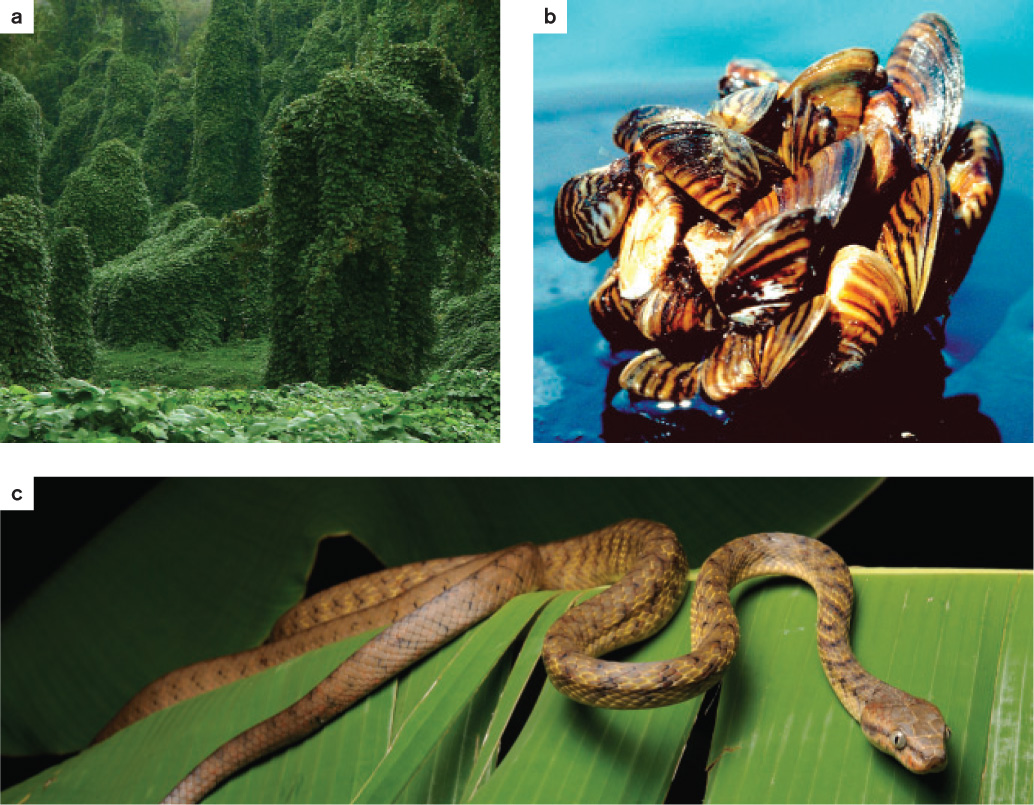
Kudzu, for example, a plant imported from Japan to retard soil erosion, now covers more than 3 million hectares in the southeastern United States, displacing native plants through competition for space and resources (Fig. 48.20a). The Zebra Mussel, a European bivalve that hitchhiked to the Great Lakes in the ballast water of cargo ships, has also multiplied dramatically in its new habitat, displacing native species and clogging intake pipes to power plants (Fig. 48.20b). Nearly 500 introduced plant species have become weeds, contributing disproportionately to crops lost each year to competition from invasive plants.
Invasive species have particularly devastating effects on islands because island species have commonly evolved with relatively few competitors or predators. Bones in Hawaiian lava caves record more than 40 bird species that existed 1000 years ago but are now extinct, eliminated by rats and pigs introduced by Polynesian colonists, as well as by landscape alteration. Introduced predators have had a similar impact on the island of Guam. Brown tree snakes introduced from Australasia since World War II have reduced native bird and reptile diversity by 75% (Fig. 48.20c).
Such introductions contribute to the changing diversity and ecology of 21st-century landscapes, but it may be the spread of modern diseases that should impress (and concern) us most. In the world of airplanes and oceangoing ships, bacteria and viruses spread much more rapidly than they did in our pre-industrial past. The H1N1 (swine) flu, a global concern in 2009, is a recent example. The first diagnosed case was identified on April 13 in Mexico, and by mid-May this flu had been reported on five continents.
Quick Check 4
How do invasive species affect species diversity of communities and ecosystems?
48.4.3 Humans have altered the selective landscape for many pathogens.
From the Black Death of the fourteenth century to the flu pandemic of 1918, disease has played a major role in human history. In the Anthropocene Period, we have unprecedented opportunity to control or even eradicate some of the great diseases of the past and present. At the same time, however, the strong selective pressures placed on pathogens by antibiotics pose a key challenge for 21st-century medicine.
Malaria, discussed in Case 4, provides an illustrative case. In any given year, malaria infects an estimated 500 million people, causing a million or more deaths. Infection is particularly severe in parts of Africa, where the direct and indirect effects of malaria account for 40% to 49% of all childhood mortality. Insecticide-soaked bed nets have proven highly effective in affected areas, reducing transmission by as much as 90%. Natural selection, however, has begun to chip away at success in controlling the disease: Mosquito strains have begun to emerge that are resistant to DDT and another family of insecticides called pyrethroids.
Quinine, a chemical extracted from the bark of the cinchona tree, was the first effective treatment for malaria, and remained in widespread use until the 1940s. Since that time, a small arsenal of antibiotics has been developed, including chloroquine, mefloquine, primaquine, and doxycycline. Their usefulness, however, has declined through time as resistance to each of these drugs has evolved in populations of Plasmodium, the infectious agent of malaria. More recently, artemisinins, antibiotics based on a traditional Chinese remedy, have proved effective in treatment. Again, however, resistant strains of malaria have been identified.
Quick Check 5
The interplay of pathogens and antibiotics again brings up the problem of the Red Queen. How does the Red Queen hypothesis apply to these kinds of interaction?
The arms race between antibiotics and pathogens is not limited to malaria. It characterizes nearly the whole range of diseases caused by viruses, bacteria, protists, and fungi that infect humans. For example, tuberculosis, a lung infection spread by inhalation of the bacterium Mycobacterium tuberculosis, causes 1.8 million deaths annually, mostly in sub-Saharan Africa, where many people are also infected with HIV (Chapter 43). Antibiotic treatment is effective, but many who are infected do not or are unable to comply with the strict regimen of daily treatment for 6 months, hastening the evolution of drug-resistant M. tuberculosis strains. This occurs because an incomplete course of antibiotics does not eradicate all the bacteria, selecting for those bacteria that are least susceptible to the antibiotic. In 2007, about half a million cases of antibiotic-resistant tuberculosis were reported. More troubling, a small percentage of these infections have been characterized as “extremely drug resistant,” meaning that the pathogens resist both standard treatments and alternative antibiotics developed over the past 20 years (Fig. 48.21). In effect, extremely drugresistant tuberculosis is untreatable.
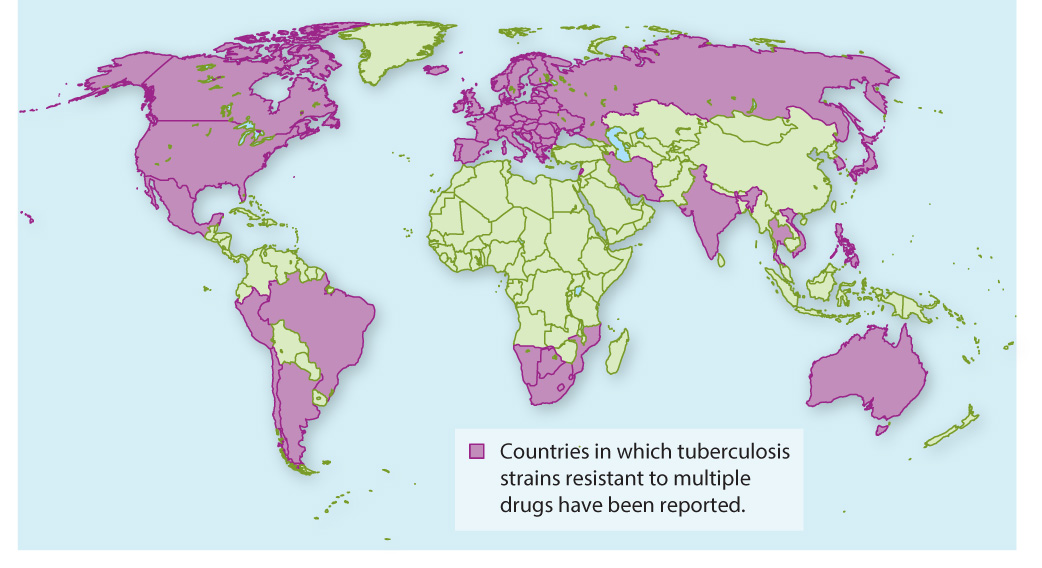
Because bacteria can pass genes horizontally (Chapter 26), antibiotic resistance evolved in one species can jump to another. Thus, the bacterial incubators for drug resistance can arise anywhere and spread rapidly.
Clearly, despite the remarkable gains of the twentieth century, public health will remain a key issue in the decades ahead. Improved sanitation—clean drinking water and safe food—can do much to reduce transmission of Earth’s great diseases, and the search is on for vaccines that can further reduce or even eliminate some historic scourges. But the ongoing evolution of drug resistance will require the continuing efforts of scientists to stay one step ahead of pathogens.
48.4.4 Are amphibians ecology’s “canary in the coal mine”?
In the nineteenth and well into the twentieth century, British, American, and Canadian coal miners sometimes took canaries with them down long mine shafts. Canaries are more sensitive than humans to carbon monoxide and other toxic gases that can accumulate in mines. When the canaries passed out, the miners knew it was time to leave. Because many amphibian species have narrow environmental tolerances and exchange gases through their skin, they can be especially sensitive to environmental disruption. For this reason, some biologists see them as “canaries” for the global environment.
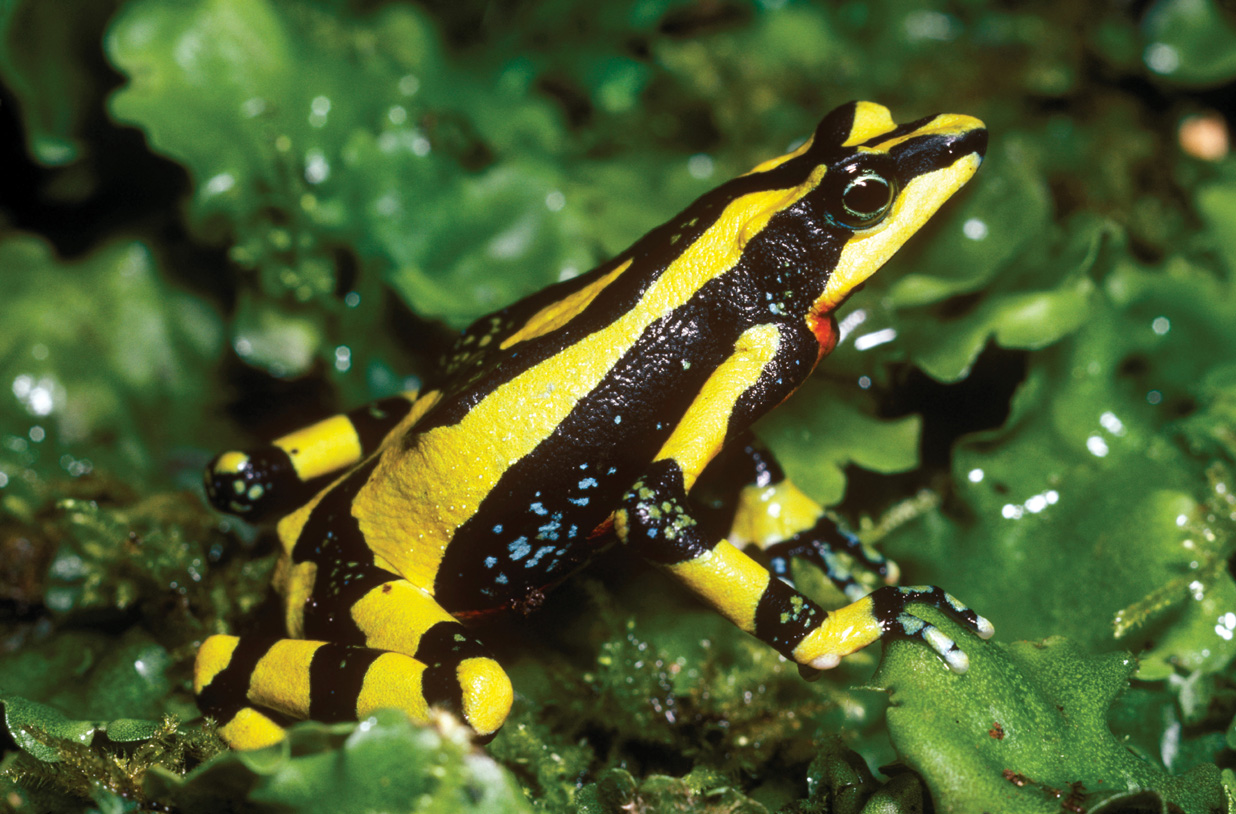
If amphibians are indeed our early-warning system, we should be concerned. Fully one-third of all amphibian species are threatened with extinction, and more than 40% have undergone significant population declines over the past decade (Fig. 48.22). What accounts for this pattern? Just about all the environmental issues discussed in this chapter come into play. Amphibian habitat is being destroyed in many parts of the world, especially old-growth forests that provide damp, food-rich environments in abundance. Pesticides and other toxins of human manufacture take their toll as well. For example, the common herbicide atrazine has been shown experimentally to impair development in frogs. Studies on placental cells grown in the laboratory suggest that atrazine in our food may also affect human reproduction. When atrazine was applied to human placental cells, it caused overexpression of genes associated with abnormal fetal development. Because of concerns about public health, atrazine has been banned in several European countries.
Recently, infection has also been implicated in amphibian decline. The fungus Batrachochytrium dendrobatidis, or Bd, infects the skin of frogs and impairs many of the skin’s functions. Recent studies of Bd show the classic features of epidemics—rapid geographic spread and high mortality—along the expanding front of fungal populations. How Bd spreads and whether it acts in concert with other facets of global change remain controversial, but there can be no doubt that disease has joined habitat destruction and pollution as a major cause of amphibian decline.